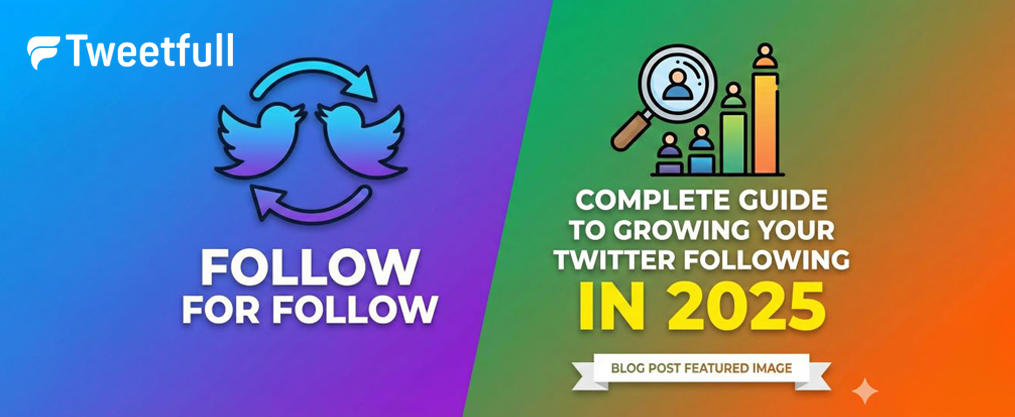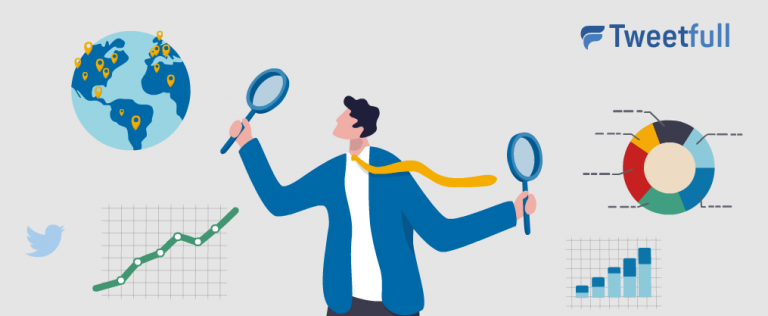Follow for Follow Twitter: Complete Guide to Growing Your Twitter Following in 2025
Growing your Twitter followers effectively is a goal for many users, whether for personal branding, business growth, or digital marketing purposes. One popular method that continues to generate interest is the follow for follow Twitter strategy. Twitter connects people from around the world, and using the follow for follow approach can help you reach and engage with a global audience.
This approach, when applied strategically, can help increase your follower count by 5-15% and build a more engaged audience. In this guide, we will explore how to leverage follow for follow tactics correctly, combining them with quality content and authentic engagement to maximize your success on Twitter in 2025.
Key Takeaways
Follow-for-follow on Twitter can be a cost-effective way to grow your audience, especially when you manually follow targeted accounts with follower counts between 1,000 and 50,000. This range tends to yield better follow-back rates and more engaged followers compared to mass following or targeting very large accounts. Maintaining a healthy follower ratio—ideally close to 1:1—is essential for your Twitter account’s credibility and to avoid algorithmic penalties.
More importantly, quality engagement matters far more than raw follower numbers. Focus on connecting with accounts in your niche that have active communities and demonstrate real interaction. Follow for follow works best when combined with creating interesting and engaging content that resonates with your target audience, allowing you to build genuine relationships and long-term success on the platform. These consistent efforts are crucial for achieving meaningful growth in the long run.
What is Follow for Follow on Twitter and How Does It Work?
Follow for follow is a social media growth tactic where users follow other Twitter accounts with the expectation that those accounts will follow them back. This method leverages the natural human tendency toward reciprocity—when someone follows your Twitter account, they often feel socially compelled to return the favor.
Unlike some social platforms that require mutual following, Twitter allows one-way following, meaning you can follow other users without them automatically following you back. For example, Facebook requires both users to accept a friend request, creating a mutual connection, whereas Twitter’s system is one-sided and does not require mutual agreement. This flexibility makes the follow for follow strategy viable because users decide whether to reciprocate based on your profile and content quality.
More importantly, quality engagement matters far more than raw follower numbers. Focus on connecting with accounts in your niche that have active communities and demonstrate real interaction. Follow for follow works best when combined with creating interesting and engaging content that resonates with your target audience, allowing you to build genuine relationships and long-term success on the platform. These consistent efforts are crucial for achieving meaningful growth in the long run. However, it’s important to note that most users on Twitter do not follow back, making follow-back an exception rather than the norm.
Follow for follow differs from organic growth, where users find your account through interesting content, retweets, or search. It also contrasts with paid Twitter ads that involve spending money to promote your profile. Instead, follow for follow requires a time investment, offering potentially faster follower gains than purely organic methods.
The key to success lies in integrating follow for follow as part of a broader digital marketing strategy. Most successful Twitter users combine this tactic with consistent posting of engaging content, authentic interactions with their target audience, and relationship-building activities that create lasting value beyond just increasing follower count.
Benefits of Using Follow for Follow Strategy on Twitter
One of the biggest advantages of follow for follow is its cost-effectiveness. Unlike Twitter ads, which can cost anywhere from $0.50 to $2.00 per follower, follow for follow requires absolutely nothing beyond your time and effort. This makes it an attractive option for new users, startups, and small businesses working with limited budgets.
Follow for follow also enables rapid initial growth. By following targeted accounts consistently, you can realistically gain between 10 and 50 new followers each day. This momentum helps overcome the early challenges many Twitter accounts face, where slow organic growth can be discouraging and hinder your ability to build credibility.
Expanding your network through following accounts in your niche increases your visibility and reach. You not only gain followers but also expose yourself to interesting content and communities, which can lead to valuable insights and collaboration opportunities.
Additionally, thoughtful follow for follow campaigns often help build relationships within your niche. By targeting accounts that share your interests or business focus, you create chances for meaningful connections that extend beyond mere follower exchanges. These relationships may result in guest posts, partnerships, or joint ventures that provide significant long-term benefits.
Finally, having a higher follower count enhances your social proof. While large numbers of followers can make your account appear more credible and authoritative, standing out from the rest of the millions of Twitter accounts requires more than just accumulating large numbers. Genuine engagement and valuable content are key to attracting organic followers and increasing your profile visits and link clicks.
How to Execute Follow for Follow Strategy Effectively
Setting Up Your Profile for Maximum Follow-Back Rate
Your Twitter profile is your first impression and plays a crucial role in convincing other users to follow back. Start by using a professional profile picture—either a clear headshot for personal brands or a high-quality logo for businesses. This image should be recognizable even at small sizes to build trust. Your Twitter profile should serve as your digital “storefront” to attract followers.
Your header image is another opportunity to communicate your brand’s value. Use the recommended dimensions (1500×500 pixels) to create a visually appealing banner that complements your bio and reinforces your niche or industry focus.
Your bio should clearly explain who you are, what you do, and why people should follow you. Make it clear what type of person you want to attract and connect with, so you can cultivate meaningful person-to-person interactions. Optimizing your profile in this way helps you attract the best audience for your content or business. Incorporate relevant keywords related to your niche to improve discoverability but avoid keyword stuffing. Including a clear call-to-action or adding a link to your website can encourage further interaction beyond simply increasing your follower count. A compelling Twitter bio should clearly state your identity, the value you provide, and relevant topics to attract followers.
Pin your best tweet to showcase your expertise and encourage immediate interaction. Pick a tweet that highlights your knowledge or provides value to your target audience, as this can be the deciding factor for users considering whether to follow back.
Maintain consistent posting activity, ideally 2-5 tweets per day, mixing original thoughts, industry news, tips, and engagement with other users. This demonstrates that your account is active and offers interesting content worth following.
Targeting the Right Accounts to Follow
Targeting is critical for follow for follow success. Focus on Twitter accounts with 1,000 to 50,000 followers, as these users typically have higher follow-back rates and engaged audiences. Accounts with fewer followers may follow back easily but often lack influence, while those with massive followings rarely reciprocate unless you provide exceptional value.
Use Twitter’s search features to find users in your niche by exploring relevant hashtags and keywords. You can also search for bios containing terms like ‘follow-for-follow’ to identify follow accounts that are likely to reciprocate. This ensures you follow people genuinely interested in your content, increasing the chances of meaningful engagement.
Before following, check engagement metrics such as likes and retweets to confirm the account’s activity level. Accounts with consistent engagement are more likely to notice your follow and evaluate your profile seriously, leading to better follow-back rates.
Avoid red flags like brand-new accounts with little content, verified accounts with millions of followers, or profiles that appear spammy or automated. There is also a risk of encountering fake accounts, which are often bots, inactive, or spam-related. Spot fake accounts by looking for generic profile pictures, lack of posts, or suspicious activity, as these accounts generally won’t follow back or add value to your network. A common variation of F4F is unfollowing accounts that do not follow back to maintain a balanced follower-to-following ratio.
You can also follow users who have recently followed similar accounts in your niche. These new users are often actively growing their networks and more willing to engage and reciprocate follows.
Best Practices for Manual Following
To avoid Twitter penalties, follow a structured process of manually following 20-50 accounts per day. This approach respects Twitter’s rate limits and keeps your account in good standing.
Before following, engage authentically with 2-3 recent tweets from the user by liking, retweeting, or commenting. This interaction increases your visibility and the likelihood that the user will check your profile and follow back.
Time your following during peak Twitter hours, typically 9-10 AM and 7-9 PM EST, when users are most active. This increases the chance they’ll see your follow notification promptly.
Keep detailed records of who you follow and when, so you can track which users follow back and plan to unfollow those who don’t after 7-14 days. Maintaining a healthy follower ratio by unfollowing non-reciprocating accounts is crucial for credibility and algorithmic success.
As advice, focus on mastering the manual process first before considering automation to ensure effective and sustainable audience growth.
Risks and Drawbacks of Follow for Follow Tactics
One major risk is Twitter’s algorithm penalizing accounts with poor follower ratios. If your following count is significantly higher than your follower count (above 1.1:1), Twitter may reduce your content’s visibility, hurting your overall reach.
Aggressive following patterns—such as mass following or rapid follow-unfollow cycles—can trigger Twitter’s spam detection, leading to temporary or permanent account suspensions. Using the wrong tactics, such as aggressive automation, can also result in penalties. Staying within daily limits and avoiding automation abuse is essential.
The quality of followers gained through follow for follow often leaves much to be desired. There is a high prevalence of fake and fake Twitter accounts among these followers, including bots and spam profiles. Relying on these types of accounts is often worse for engagement, as many follow back purely out of reciprocity without genuine interest, resulting in low engagement, no retweets, and minimal profile visits or link clicks. This creates vanity metrics that don’t translate into meaningful business results. If you’re interested in learning effective methods to gain real Twitter followers, there are proven strategies you can use instead.
The time investment can also be significant. Researching accounts, engaging with content, following strategically, tracking results, and unfollowing can consume hours each week. For many, this time might be better spent creating engaging content or directly interacting with their audience.
Lastly, follow for follow can harm your reputation if your account is seen as spammy or focused solely on follower numbers. This perception can damage your personal or business brand, especially among industry peers.
Follow for Follow vs. Other Twitter Growth Strategies
Comparing Costs and Results
Follow for follow is the most budget-friendly growth method, requiring only your time rather than money. You can gain 10-50 followers daily, but engagement quality varies widely. However, using automation tools is only part of the job—building a strong, professional profile and setting clear goals are also essential for effective growth.
Twitter ads offer more predictable and often higher quality results but come at a cost—typically $50-$200 monthly. They can generate 20-100 new followers daily with better targeting and conversion rates.
Organic content strategies, while slower, provide the highest engagement and long-term growth. They require minimal financial investment and produce followers genuinely interested in your niche.
Influencer collaborations are premium strategies costing hundreds to thousands per campaign but deliver highly targeted followers and excellent ROI for business goals.
When to Use Follow for Follow Strategy
Follow for follow is ideal for new Twitter accounts with fewer than 1,000 followers to overcome initial growth hurdles. It helps build credibility and attracts organic followers.
Niche businesses benefit by targeting specific communities where reciprocal following leads to valuable connections and business opportunities.
Personal brands and thought leaders can use it to network strategically, connecting with peers and influencers in their industry.
Budget-conscious marketers may use it as a low-cost method for initial audience development and market research before investing in paid ads or content campaigns.
Taking a course on social media strategy can provide structured guidance on follower engagement, follow-back practices, and social media etiquette, helping users understand when and how to use follow for follow effectively.
Tools and Automation for Follow for Follow
Manual tools like Twitter’s native search and TweetDeck are safest for managing follow for follow campaigns. They help you find relevant accounts and organize your activity without risking penalties.
Automation platforms such as Owlead, Hypefury, and Buffer offer features like scheduled following and automatic unfollowing, reducing time investment. Some of these tools can automatically follow and unfollow accounts on your behalf, but must be used carefully to comply with Twitter’s rules. Many users do not realize that automation alone does not guarantee genuine engagement or success—authentic interactions are still essential for building a meaningful audience. Using Twitter automation tools can help users target specific audiences based on their interests.
Analytics tools like Sprout Social and Hootsuite provide insights into follow-back rates, engagement, and follower retention, helping you optimize your strategy.
Always respect daily limits (stay below 100 follows per day) and avoid spammy automation. Manual methods, though time-consuming, offer the best long-term security for your account.
Measuring Success and Optimizing Your Follow for Follow Campaign
Track your follow-back rate aiming for 15-25% as a healthy benchmark. Rates above 30% often indicate low-quality, indiscriminate follows, while rates below 5% suggest issues with targeting or profile setup.
Monitor engagement metrics such as likes, retweets, comments, link clicks, and profile visits relative to your follower growth. For example, analyze a specific account’s engagement by comparing the number of likes and retweets per post to its follower count to identify patterns in audience interaction. Declining engagement despite rising follower counts signals poor follower quality.
Use A/B testing to optimize your bio, posting schedule, and targeting criteria. Experiment with different profile descriptions, header images, pinned tweets, and follow times to find what works best for your niche. After testing, you can create a post summarizing your findings to share with your audience and demonstrate effective strategies.
Review monthly performance to identify which types of accounts provide the best follow-back and engagement combination. Refine your targeting to focus on these for maximum efficiency.
Set realistic goals, such as gaining 500-2000 new followers monthly, emphasizing quality engagement over sheer numbers.
Alternatives to Follow for Follow Strategy
Long-term sustainable growth comes from content-driven strategies, such as creating viral tweets, participating in trending hashtags, and producing shareable threads that showcase your expertise. Sharing valuable stuff with your audience helps attract and retain followers who are genuinely interested in what you offer.
Engaging in Twitter chats and industry conversations builds authentic relationships and establishes your reputation, often more valuable than follower count alone. Meaningful talk and genuine interactions are key to fostering a loyal community, rather than just focusing on numbers.
Cross-platform promotion from Instagram, LinkedIn, email marketing, and other channels drives followers already interested in your content, resulting in higher engagement.
Partnerships and influencer collaborations provide mutually beneficial growth opportunities, expanding your reach and credibility.
Hosting or guest appearing on Twitter Spaces allows you to share expertise with targeted audiences, attracting followers genuinely interested in your niche. It’s important to focus on connecting with real people, not bots, to ensure authentic engagement and long-term success.
FAQ
Is follow for follow against Twitter’s terms of service?
Follow for follow itself is not prohibited, but aggressive automation and spam-like behaviors are against Twitter’s rules. Manual following combined with authentic engagement is generally acceptable if you respect rate limits and avoid bot-like patterns.
How long should I wait before unfollowing someone who doesn’t follow back?
Wait 7-14 days to give users enough time to notice your follow. Immediate unfollowing reduces chances of reciprocation. Use tools or spreadsheets to track follow dates and automate unfollowing.
What’s a good follow-back rate for follow for follow campaigns?
Aim for 10-25%. Rates above 30% often indicate low-quality follows, while below 5% suggests targeting or profile issues needing adjustment.
Can follow for follow help me get verified on Twitter?
No. Verification depends on authenticity, notability, and public interest, not follower count. Focus on building genuine authority and external recognition.
Should I follow back everyone who follows me first?
No. Review profiles to avoid following bots, spam, or irrelevant accounts. Selective follow-back maintains quality and engagement.
By understanding and applying these follow for follow Twitter strategies thoughtfully and ethically, you can grow your followers effectively in 2025. Remember, combining this tactic with engaging content and authentic interaction is the key to building a valuable Twitter presence that stands the test of time.







